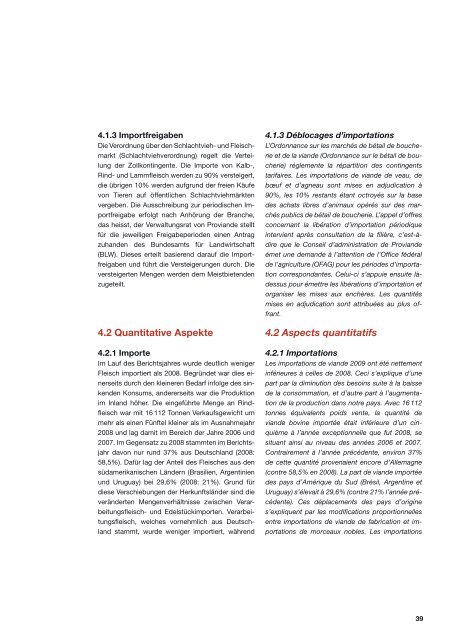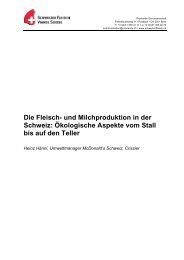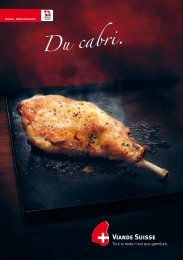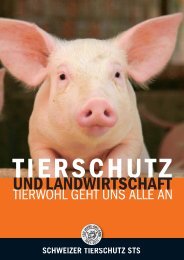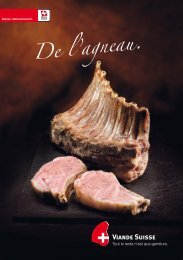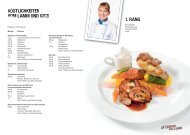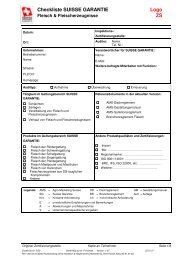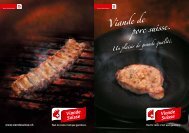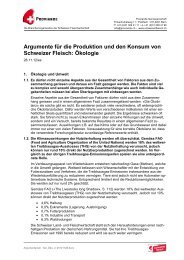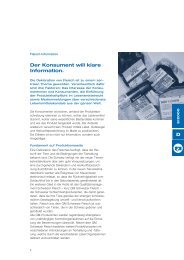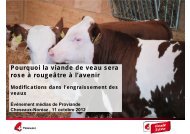Le marché de la viande - Schweizer Fleisch
Le marché de la viande - Schweizer Fleisch
Le marché de la viande - Schweizer Fleisch
Create successful ePaper yourself
Turn your PDF publications into a flip-book with our unique Google optimized e-Paper software.
4.1.3 Importfreigaben<br />
Die Verordnung über <strong>de</strong>n Sch<strong>la</strong>chtvieh- und <strong>Fleisch</strong>markt<br />
(Sch<strong>la</strong>chtviehverordnung) regelt die Verteilung<br />
<strong>de</strong>r Zollkontingente. Die Importe von Kalb-,<br />
Rind- und Lammfleisch wer<strong>de</strong>n zu 90% versteigert,<br />
die übrigen 10% wer<strong>de</strong>n aufgrund <strong>de</strong>r freien Käufe<br />
von Tieren auf öffentlichen Sch<strong>la</strong>chtviehmärkten<br />
vergeben. Die Ausschreibung zur periodischen Importfreigabe<br />
erfolgt nach Anhörung <strong>de</strong>r Branche,<br />
das heisst, <strong>de</strong>r Verwaltungsrat von Provian<strong>de</strong> stellt<br />
für die jeweiligen Freigabeperio<strong>de</strong>n einen Antrag<br />
zuhan<strong>de</strong>n <strong>de</strong>s Bun<strong>de</strong>samts für Landwirtschaft<br />
(BLW). Dieses erteilt basierend darauf die Importfreigaben<br />
und führt die Versteigerungen durch. Die<br />
versteigerten Mengen wer<strong>de</strong>n <strong>de</strong>m Meistbieten<strong>de</strong>n<br />
zugeteilt.<br />
4.2 Quantitative Aspekte<br />
4.2.1 Importe<br />
Im Lauf <strong>de</strong>s Berichtsjahres wur<strong>de</strong> <strong>de</strong>utlich weniger<br />
<strong>Fleisch</strong> importiert als 2008. Begrün<strong>de</strong>t war dies einerseits<br />
durch <strong>de</strong>n kleineren Bedarf infolge <strong>de</strong>s sinken<strong>de</strong>n<br />
Konsums, an<strong>de</strong>rerseits war die Produktion<br />
im In<strong>la</strong>nd höher. Die eingeführte Menge an Rindfleisch<br />
war mit 16 112 Tonnen Verkaufsgewicht um<br />
mehr als einen Fünftel kleiner als im Ausnahmejahr<br />
2008 und <strong>la</strong>g damit im Bereich <strong>de</strong>r Jahre 2006 und<br />
2007. Im Gegensatz zu 2008 stammten im Berichtsjahr<br />
davon nur rund 37% aus Deutsch<strong>la</strong>nd (2008:<br />
58,5%). Dafür <strong>la</strong>g <strong>de</strong>r Anteil <strong>de</strong>s <strong>Fleisch</strong>es aus <strong>de</strong>n<br />
südamerikanischen Län<strong>de</strong>rn (Brasilien, Argentinien<br />
und Uruguay) bei 29,6% (2008: 21%). Grund für<br />
diese Verschiebungen <strong>de</strong>r Herkunftslän<strong>de</strong>r sind die<br />
verän<strong>de</strong>rten Mengenverhältnisse zwischen Verarbeitungsfleisch-<br />
und E<strong>de</strong>lstückimporten. Verarbeitungsfleisch,<br />
welches vornehmlich aus Deutsch<strong>la</strong>nd<br />
stammt, wur<strong>de</strong> weniger importiert, während<br />
4.1.3 Déblocages d’importations<br />
L’Ordonnance sur les marchés <strong>de</strong> bétail <strong>de</strong> boucherie<br />
et <strong>de</strong> <strong>la</strong> vian<strong>de</strong> (Ordonnance sur le bétail <strong>de</strong> boucherie)<br />
réglemente <strong>la</strong> répartition <strong>de</strong>s contingents<br />
tarifaires. <strong>Le</strong>s importations <strong>de</strong> vian<strong>de</strong> <strong>de</strong> veau, <strong>de</strong><br />
bœuf et d’agneau sont mises en adjudication à<br />
90%, les 10% restants étant octroyés sur <strong>la</strong> base<br />
<strong>de</strong>s achats libres d’animaux opérés sur <strong>de</strong>s marchés<br />
publics <strong>de</strong> bétail <strong>de</strong> boucherie. L’appel d’offres<br />
concernant <strong>la</strong> libération d’importation périodique<br />
intervient après consultation <strong>de</strong> <strong>la</strong> filière, c’est-àdire<br />
que le Conseil d’administration <strong>de</strong> Provian<strong>de</strong><br />
émet une <strong>de</strong>man<strong>de</strong> à l’attention <strong>de</strong> l’Office fédéral<br />
<strong>de</strong> l’agriculture (OFAG) pour les pério<strong>de</strong>s d’importation<br />
correspondantes. Celui-ci s’appuie ensuite là<strong>de</strong>ssus<br />
pour émettre les libérations d’importation et<br />
organiser les mises aux enchères. <strong>Le</strong>s quantités<br />
mises en adjudication sont attribuées au plus offrant.<br />
4.2 Aspects quantitatifs<br />
4.2.1 Importations<br />
<strong>Le</strong>s importations <strong>de</strong> vian<strong>de</strong> 2009 ont été nettement<br />
inférieures à celles <strong>de</strong> 2008. Ceci s’explique d’une<br />
part par <strong>la</strong> diminution <strong>de</strong>s besoins suite à <strong>la</strong> baisse<br />
<strong>de</strong> <strong>la</strong> consommation, et d’autre part à l’augmentation<br />
<strong>de</strong> <strong>la</strong> production dans notre pays. Avec 16 112<br />
tonnes équivalents poids vente, <strong>la</strong> quantité <strong>de</strong><br />
vian<strong>de</strong> bovine importée était inférieure d’un cinquième<br />
à l’année exceptionnelle que fut 2008, se<br />
situant ainsi au niveau <strong>de</strong>s années 2006 et 2007.<br />
Contrairement à l’année précé<strong>de</strong>nte, environ 37%<br />
<strong>de</strong> cette quantité provenaient encore d’Allemagne<br />
(contre 58,5% en 2008). La part <strong>de</strong> vian<strong>de</strong> importée<br />
<strong>de</strong>s pays d’Amérique du Sud (Brésil, Argentine et<br />
Uruguay) s’élevait à 29,6% (contre 21% l’année précé<strong>de</strong>nte).<br />
Ces dép<strong>la</strong>cements <strong>de</strong>s pays d’origine<br />
s’expliquent par les modifications proportionnelles<br />
entre importations <strong>de</strong> vian<strong>de</strong> <strong>de</strong> fabrication et importations<br />
<strong>de</strong> morceaux nobles. <strong>Le</strong>s importations<br />
39


